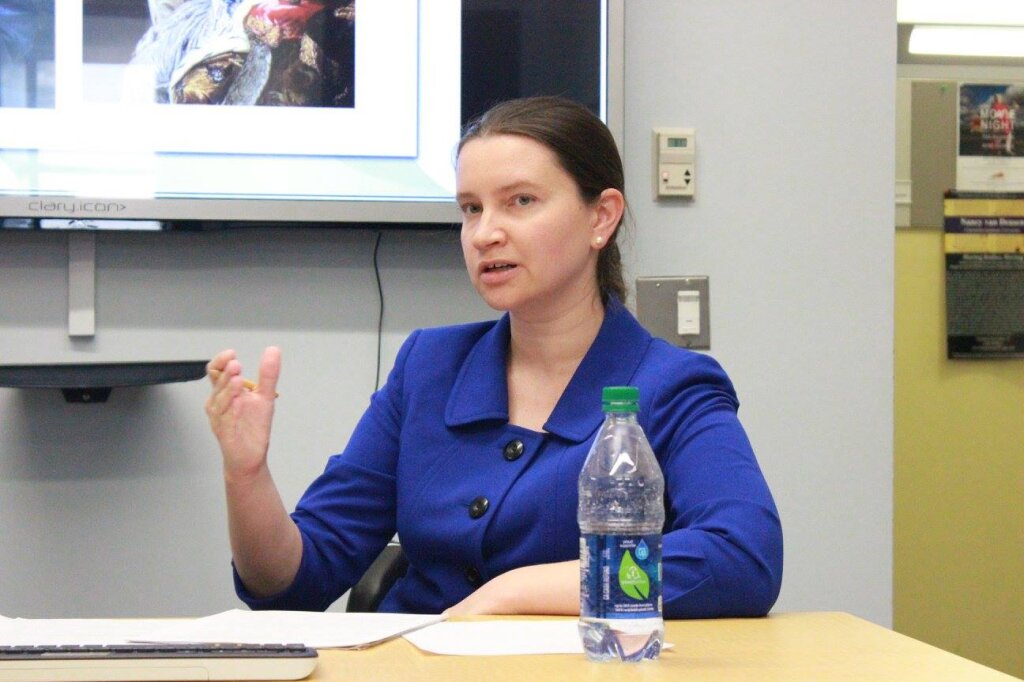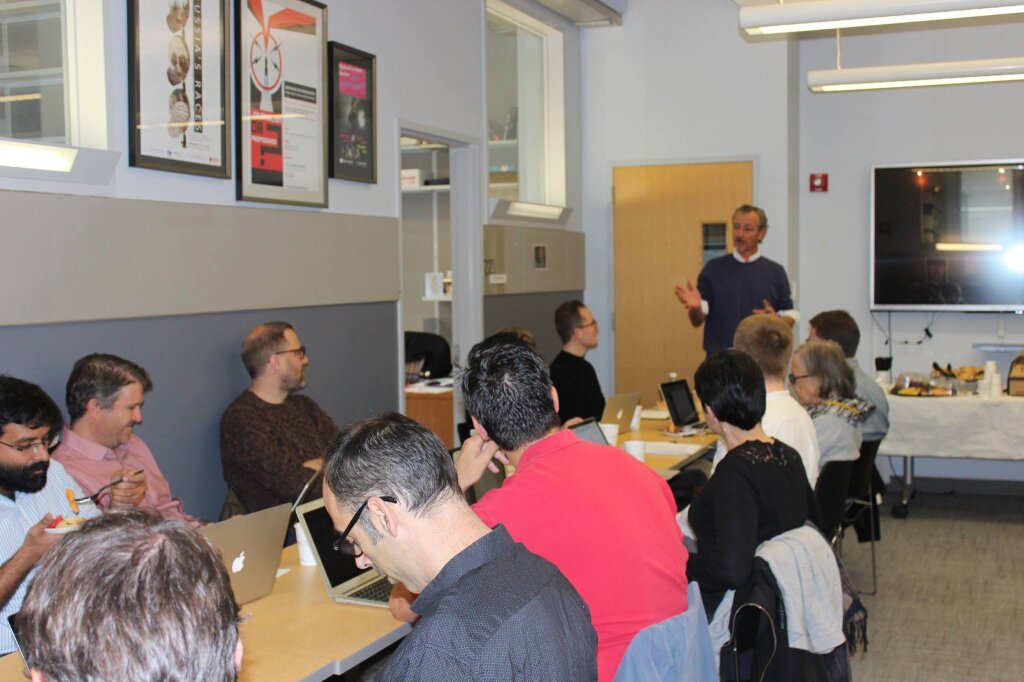On November 6, 2015, the NYU Jordan Center for the Advanced Study of Russia welcomed writer-in-residence Oksana Mykhed to present a lecture titled “A Plague on your Borders: Public Health and the Making of Russian Imperial Boundaries in Ukraine, 1762-95.” The lecture was based on a chapter from her upcoming book on the history of incorporation of Right-Bank and Central Ukraine into the Russian Empire between 1762 and 1860. As explained by NYU Professor Anne O’Donnell in her introduction, Mykhed defended her PhD dissertation at Harvard University in 2014 and was previously affiliated with the Harriman Institute at Columbia University and the Harvard Ukrainian Research Institute.
“One of the major arguments in the book is the idea that the empire relied on many non-coercive methods in incorporating the territories in Ukraine and Poland during the eighteenth century,” Mykhed stated at the beginning of her talk. She explained that the monograph explores three different areas that showcase the empire’s experimentation with non-coercive policies—public health, social relations and economy. The lecture focused on one of these areas—public health—and the history of bubonic plague epidemics in the territories of 18th-century Ukraine. According to Mykhed, her study aimed at proving that the plague played a significant role in pushing the imperial government to initiate a series of medical and border security reforms in the Ukrainian Dnieper region, located between the Russian Empire and the Polish-Lithuanian Commonwealth, and eventually facilitated the incorporation of the area into the Russian Empire in 1782-85.
“When I was digging deeper into the history of the region I was struck by a number of Polish and Russian attempts to contest the Ukrainian borderland,” Mykhed observed. She noted, however, that such attempts did not lead to any significant assertion of full Polish or Russian government control over the region, which continued to enjoy a significant degree of autonomy. She identified the 1686 Eternal Peace Treaty between the Tsardom of Muscovy and the Polish-Lithuanian Commonwealth as the first significant attempt to define a precise border. The treaty, which was a necessary step to further the alliance between the two reigns against the Ottoman Empire, established a division between the right and left side of the Dnieper borderland. While Right-Bank Ukraine came to be under the direct jurisdiction of the Russian authorities, the left side was assigned to Poland.
“This treaty never resulted in an officially demarcated border,” Mykhed said, but did stimulate the construction of the Kiev outpost line. In 1762, the outpost line was, however, ill-defined, ill-patrolled and kept in bad conditions; it was also maintained with the sole participation of the Russian authorities, whose resources—from gun powder to horse food—were miserly and of low quality.
Mykhed also said that peasants on the borderlands lacked a strong national identity and a sense of the border. “They recognized themselves neither Russian nor Polish,” she added. When Catherine II came to power, the lack of a clear border demarcation was first approached. Mykhed explained that Catherine’s reign marked the era of geographic explorations, in great part fueled by a new impetus towards the reorganization of the empire under principles of rationality and order. Catherine organized an expedition to the Russo-Polish borderlands that discovered the lack of a clear border, and decided to approach the issue. At the time, Stanislaw Poniatowski, the new Polish king and a friend of Catherine, had demonstrated an interest in collaborating with the empress in solving the issue of demarcation. The king would later prove to be largely dependent on the Polish nobility, which did not share the empire’s enthusiasm with a change in the political status of the Ukrainian borderland.
In the meantime, Pyotr Rumyantsev, an eminent Russian general dispatched to survey the region, expressed concern with the number of peasants fleeing the Russian side for the Polish one. Mykhed said that the peasants were mostly attracted by the promise of freedom from taxes, serfdom and military conscription offered by the Polish nobility. The peasant flight led to the creation of a whole community of free settlers and runaway peasants who often engaged in banditry and smuggling.
Unregulated population movement facilitated the diffusion of contagious diseases in the region. The first outbreaks of bubonic plague were documented right before Catherine became empress. In the 18th century there was no treatment for the plague, and people often trusted popular wisdom and faulty medical theories. The effect was catastrophic; in some villages of the region the plague led to the demise of 80 percent of the population.
The major focus of the talk was the 1770-71 plague outbreak in the Russo-Polish borderland, the last and the most disastrous medical catastrophe in the area. According to the author, the lack of a closed border contributed significantly to the spread of the disease, given the lack of control over population migration and circulation of imported commodities. Another contributing factor was the exposition of the region to the Russo-Ottoman War, due to the stationing in the area of medical professionals and sergeants previously located in the Ottoman Empire. Finally, the lack of adequate quarantining procedures in Kiev and the lack of qualified physicians in the major borderland hub exacerbated the problem.
Mykhed pointed out that in a short time the importance of a closed border became evident, and that this prompted a series of reforms. “The plague outbreak served as a catalyst for the establishment of a new system of border security,” the author argued. Between 1781 and 1783 the official border was finally delineated. Funding to improve border security was allocated, and new teams of quarantine physicians were sent to the region from St. Petersburg. These changes proved effective, and in 1793 and 1797 new plague outbreaks in Right-Bank and Southern Ukraine did not have significant impact on the population of the major borderland cities.
Mykhed also noted that the new reforms proved beneficial for migration control and economy, attracting new labor and leading to population growth. Peasant flight from the empire was targeted through the establishment of a system of awards for those who reported any known cases and the introduction of a passport requirement to travel abroad. New representatives of the imperial government in the provinces, the namestniki, led local elites and established stricter controls over the peasantry, while a new local police was called to bring order. “The reforms changed the entire landscape of the borderlands and established a constant presence of imperial officials in the region,” Mykhed concluded.
In the Q&A session that followed the lecture, Seton Hall Professor Nathaniel Knight inquired about the sources of knowledge which stood behind the use of primitive methods of disinfection and sanitation popular before the reforms. Mykhed noted that in the mid-18th century most anti-plague precautions drew on intuitive practices approved by medical professionals based on the miasma theory. O’Donnell asked about what made the Dnieper borderland between Russia and Poland significant in the fight against the plague in comparison with other borders of the empire. Mykhed’s answer stressed the unique status of the region as a contested territory exposed to major European and Ottoman trade routes and its connection with Moscow and St. Petersburg. The discussion that followed was provoked by questions about the role of the Jewish population in the borderlands in stopping the plague and implementation of reforms. Mykhed stressed the importance of the Jews as leading physicians, pharmacists, merchants and lawyers who served as liaisons between the imperial authorities and the borderland population.



